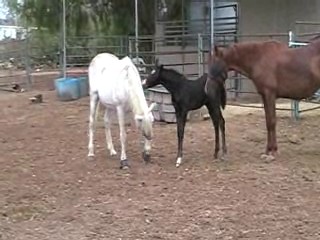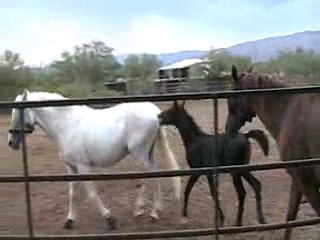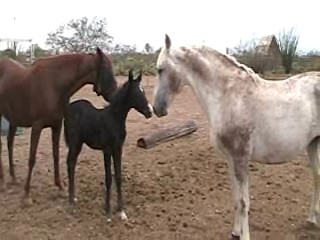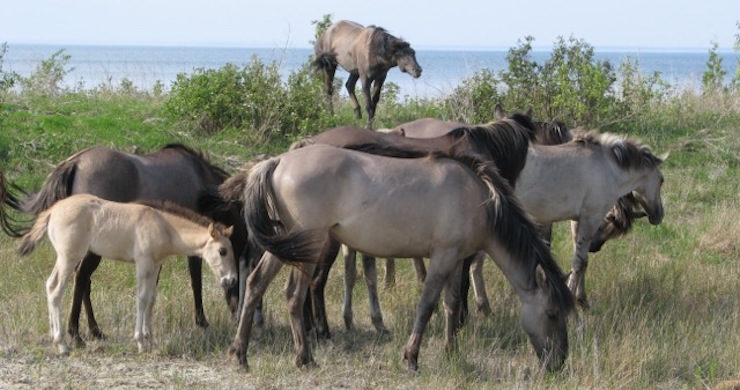For those who are looking for “Sleipnir Rides Again (and Gets Super Mystical)”, we’re saving that for a more appropriate date. Look for it on the day between the years, January 1st. Meanwhile, as we all descend deeper into the Twilight Zone of the year, here’s a little joy for the season, and a question near and dear to my horse-breeder heart.
In the comments on the last Ask SFF Equine, gustovcarl asked: In your book “Writing Horses…” you mentioned briefly that stallions can be good fathers. Do you have any examples or stories about this subject?
First of all let me refer you to a lovely article by my esteemed colleague and fellow stallion enthusiast Kip Mistral: “The Secret Life of Stallions.” And here, have some wild stallions being husbands, fathers, and herd guardians.
Stallions are much too negatively portrayed in our culture: they’re not nearly as dangerous or aggressive as advertised. In the wild, herd stallions recognize and protect their offspring, and observers have often seen dad babysitting the kid while mom takes a well-earned break.
Domestic stallions are too often kept under terrible conditions—isolated, handled with fear and aggression, and never allowed near a mare except to breed. The mare is often forcibly restrained, so that the whole experience adds up to equine rape.
These stallions never get a chance to get to know their mares, and the mares are given no choice about the encounter. The offspring will be born far away from their father, and he may never know or be allowed to know any of his sons and daughters. It’s “too dangerous.”
I’m retired from horse breeding now, but still have a stallion and a small herd of mares. Back when we were an active breeding farm, he did boy-in-a-box—artificial insemination both in situ and for shipping across the country—and hand-breeding with handlers for both mare and stallion, both of which are deemed much safer for valuable horses than turning them loose and letting nature take its course.
These methods are safer, it’s true; one particularly terrible story haunts me, of an older stallion who had never bred a live mare, a mare who had never been bred except by turkey baster, and an uneducated owner who turned them out together and then went away for the day. The stallion was injured and the mare died—in the melee, she caught a hoof to the head. Neither of them knew how to behave, or had any guidance from humans or more experienced horses.
But that’s straying from the topic. At one point a friend had an experienced older mare whom she wanted bred to my stallion. She convinced me to try pasture breeding under supervision, with both of us there and ready to intervene if necessary. The mare had already been bred to my stallion and had delivered a colt, and she was in the foal heat, which is when a mare is most receptive to the stallion. (Ohhh, is she.)
The mare had foaled elsewhere and was brought in just before she came into heat. Stallion had last seen her the year before, when she went home after being bred (and that’s a story in itself: baby hid from vet’s ultrasound, he pronounced her Not In Foal, it was too late in the season to try again, then in the spring she produced a big, beautiful surprise). As mare and baby arrived, stallion became extremely excited—not his usual reaction to a new arrival. When his son came off that trailer behind mom, dad drank and drank the scent, and became even more excited, whickering and staring intently. He had never done this with any foal by any other stallion. He knew that baby was his.
A few days later, mom was ready. Normally when we breed a mare back, we put baby next to the parents, with a secure wall between, to keep him safe. But friend said mom had been bred at liberty before, with baby. We took the chance.
Stallion was extremely respectful of no-nonsense older lady. She kept herself between baby and dad, very watchful, very clear: Do Not Mess With Baby.

When she was satisfied that dad had got the message, she allowed curious baby to investigate the fascinating new horse. Within minutes, that little snot was all over his dad, herding him, nipping him, climbing on him. Dad was fine with it—a little leery, because mom was giving him the hairy eyeball, but taking his cue from her and clearly enjoying playing with his kid. He even relaxed enough to go down and roll, which is a sure indication that the horse is at ease with his surroundings.

She let that go on for a while, then let him know it was time to make the next kid. And he followed her lead, respectfully, and she showed him what to do.

We didn’t leave them together unsupervised, but we turned them out together for a few hours a day, till the mare let us know she’d had enough, please take the annoying boy away. The next year she delivered a lovely filly; she was of such an age by then that we opted not to try again.
That filly stayed with us after mom went home, and frequently hung out with her father along the fence line. When it came time for her to go to her new owner, it was dad who showed her how to load on the trailer, and traveled with her to reassure her that all was well. He was very gentle with her, and very calm and calming.
One of his other daughters was the result of his first live breeding. That one we did in hand because the mare was a lease and her owner did not authorize pasture breeding. Her foal by another stallion stayed next to her in a safe stall.
Later when the mare went back to her owner, we were the object of awe because the Great Bitch Goddess of the Universe had allowed our stallion to touch her sacred self. Apparently she was hammer-heeled death to their stallions. She was all sweetness to ours. She ended up back here at retirement, and is now my trail horse. Her two daughters whom we kept here are BFFs.
When this pair’s daughter was born, she proved to be immune to electric fencing. She walked right through. (In adulthood she had to be kept in a pasture with cattle-grade electric—the kind that can kill a human toddler. She allowed as how that was a little more than she was prepared to challenge.) We would find mom running up and down in a fit of anxiety, and baby contentedly hanging with dad in his paddock. He was perfectly happy to look after the kid, was much gentler with her than her mother was.
Daughter has long since moved on, but dad and mom still have a thing for each other. When I’m riding dad, mom will call to him from her stall, and sometimes squeal and flounce to get his attention. Just the other day he’d had enough of that, so (with me aboard) squealed back, did a pair of equestrian-statue-grade levades, each followed by a firm STOMP of both front feet, then carried on with our exercises.
When I ride mom, who despises boring ring work and prefers to go Out, dad gets all a-swivet. She might! not! come back! But she always does. She’ll flip her tail at him on the way out, just to be sure he knows who’s in charge here.
The mare, of course. Always the mare. That’s the way the world of horses is supposed to work.
Judith Tarr is a lifelong horse person. She supports her habit by writing works of fantasy and science fiction as well as historical novels, many of which have been published as ebooks by Book View Cafe. Her most recent short novel, Dragons in the Earth, features a herd of magical horses, and her space opera, Forgotten Suns, features both terrestrial horses and an alien horselike species (and space whales!). She lives near Tucson, Arizona with a herd of Lipizzans, a clowder of cats, and a blue-eyed dog.










